If you’re planning a trip to Costa Rica, you’ll need to familiarize yourself with the country’s currency, the Colón. The Colón has a rich history, having been introduced in 1896 to replace the peso at par. Today, it remains the official currency of Costa Rica and is used by both locals and tourists alike.
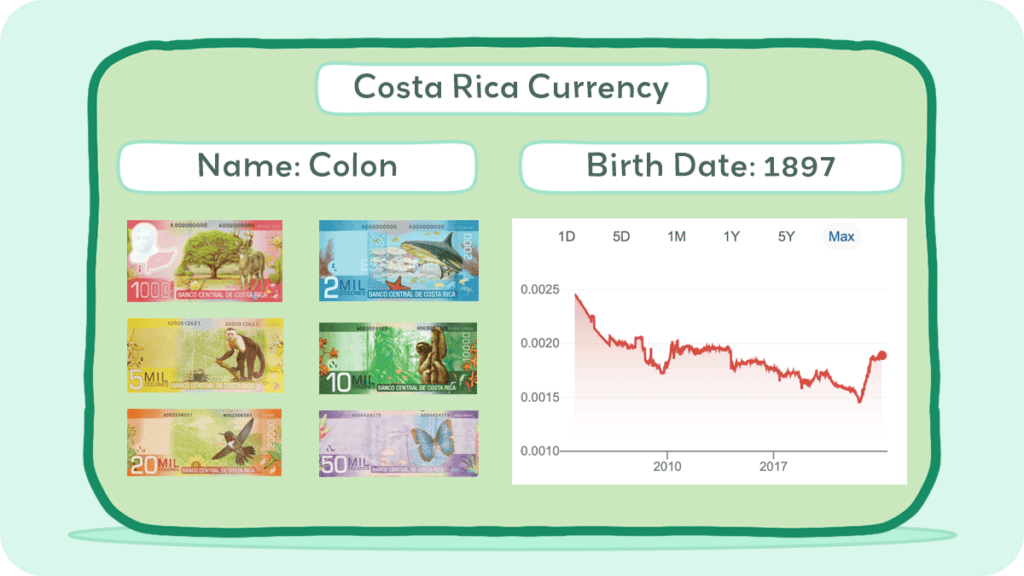
The currency has undergone many changes over the years, including the release of new colorful waterproof banknotes between 2012 and 2014. These bills come in denominations of ₡1,000, ₡2,000, ₡5,000, ₡10,000, ₡20,000, and ₡50,000, with coins of 5, 10, 25, 50, 100, and 500 colones.
Whether you’re exchanging currency before your trip or withdrawing money from an ATM in Costa Rica, it’s important to understand the value of the Colón and how to use it. In this article, we’ll take a closer look at the history of the Colón, as well as some interesting facts about Costa Rica’s currency that you may not know.
Historical Journey of Costa Rican Colón
Costa Rican Colón (CRC) is the official currency of Costa Rica, a Central American country known for its rich biodiversity and natural beauty. The currency has a long and interesting history that dates back to the 19th century. In this section, we will take a closer look at the historical journey of the Costa Rican Colón.
History of Coins
In 1897, Costa Rica saw the introduction of its first coins—gold 2, 5, 10, and 20 colones. Fast forward to 1903, and silver 50 centimos were added, followed by cupro-nickel 2 centimos and silver 5 and 10 centimos in 1905. Notably, the 5 and 10 centimos had G.C.R. initials, signifying their government origin.
Moving to 1917, 5 and 10 centavo coins were issued, with 50 centavo coins minted but not released. Government-issued coins made a comeback in 1920 with 5 and 10 centimos. In 1923, silver 25 and 50 centimos from the peso currency were stamped, doubling their values to 50 centimos and 1 colón.
The International Bank of Costa Rica stepped in during 1935, issuing cupro-nickel coins—25 and 50 centimos and 1 colón—with the initials B.I.C.R. Banco Nacional joined the coinage scene in 1937, introducing coins with denominations of 25 and 50 centimos and 1 colón, marked with the initials B.N.C.R.
Banco Central entered the picture in 1951, rolling out 5 and 10 centimo coins. By 1982-1983, 5 and 10 centimo coins were phased out, making way for 25, 50, and 100 colones coins. In 2003, 500 colones joined the ranks, followed by aluminum 5 and 10 colones in 2006.
Come 2009, the larger silver-colored ₡5, ₡10, and ₡20 coins were gradually withdrawn, leaving smaller, lighter ₡5 and ₡10, along with gold-colored coins, in circulation. The ₡5 coin bid farewell at the end of 2019.
History of Bills
In addition to coins, Costa Rica has also issued many different bills over the years. Private banks played a significant role in Costa Rica’s monetary history from 1896 to 1914. Four notable ones—Banco Anglo–Costarricense, Banco Comercial de Costa Rica, Banco de Costa Rica, and Banco Mercantil de Costa Rica—issued notes during this period.
The Banco Anglo–Costarricense, established in 1864, issued notes until 1917. Initially a private institution, it later became state-owned, facing bankruptcy and closure in 1994. The notes, denominated in 1, 25, 50, and 100 pesos, as well as 5, 10, 20, 50, and 100 colones, bore historical significance.
Some 1, 5, 10, and 20 colones notes were released in 1963, commemorating the bank’s centennial, with some marked as “sample without value” to nullify legal tender status.
The Banco de Costa Rica, founded in 1890, issued notes from 1890 to 1914. Currently a state-owned bank, it released notes in denominations of 1, 2, 5, 10, 20, and 100 pesos, along with 5, 10, 20, 50, and 100 colones.
The Banco Comercial de Costa Rica issued notes between 1906 and 1914, featuring denominations of 5, 10, 20, 50, and 100 colones. Similarly, the Banco Mercantil de Costa Rica issued notes from 1910 to 1916 in denominations of 5, 10, 20, 50, and 100 colones.
Transitioning to government issues from 1897 to 1917, gold certificates were introduced for 5, 10, 25, 50, and 100 colones in 1897. Subsequently, silver certificates were issued between 1902 and 1917 for 50 centimos, 1, 2, 50, and 100 colones.
The period of Banco Internacional from 1914 to 1936 marked the introduction of notes in denominations of 5, 10, 20, 50, and 100 colones. Additional values, including 25 and 50 centimos and 1 and 2 colones, were added in 1918. While 25 centimos were discontinued after 1919, other denominations continued until 1936, making Banco Internacional’s notes the sole circulated currency after 1917.
Banco Nacional took charge of paper money issuing in 1937, producing notes for 1, 2, 5, 10, 20, 50, and 100 colones until 1949. Early notes often involved provisional issues overprinted on Banco Internacional notes, including briefly issued 1 colón notes.
From 1950 onward, Banco Central de Costa Rica began issuing paper money, initially with provisional notes from Banco Nacional. Regular notes began in 1951, with subsequent additions such as 2 colones in 1967, 1,000 colones in 1958, 500 colones in 1973, 5,000 colones in 1992, 2,000 and 10,000 colones in 1997, and 20,000 and 50,000 colones in 2011.
Inflation and Buying Power of Colón

The Costa Rican Colón (CRC) has experienced significant inflation over the years, which has affected its buying power. According to the Inflation Tool, the inflation rate in Costa Rica between 1977 and 2021 was 20,470%, which translates into a total increase of ₡20,470. This means that 100 colones in 1977 are equivalent to 20,570 colones in 2021. The average annual inflation rate between these periods was 12.87%.
Based on data from the World Bank, the CRC has lost 99.829% of its value since 1960. The ₡100 in 1960 is equivalent in purchasing power to about ₡58,564.27 today. The Colón had an average inflation rate of 10.64% per year between 1960 and today, producing a cumulative price increase of 58,464.27%.
The high inflation rate in Costa Rica has led to a decrease in the purchasing power of the CRC. This means that goods and services that cost less in the past are now more expensive, and people need to spend more money to buy the same things. However, the government has implemented measures to control inflation and stabilize the economy.
To help you understand the impact of inflation on the CRC, here is a table showing the purchasing power of ₡100 at different times:
| Year | Purchasing power of ₡100 |
| 1960 | ₡58,564.27 |
| 1977 | ₡20,570.00 |
| 2021 | ₡0.49 |
As you can see, the purchasing power of ₡100 has significantly decreased over the years due to inflation. It is important to keep this in mind when dealing with the CRC and making financial decisions in Costa Rica.
The Colón
If you’re planning a trip to Costa Rica, it’s important to familiarize yourself with the country’s currency. The national currency of Costa Rica is the Costa Rican Colón (CRC), named after Christopher Columbus or Cristobal Colón. Costa Rica currency symbol is abbreviated as “₡”.
The Costa Rican Colón is divided into 100 centimos, but you’ll rarely see coins in circulation. Instead, you’ll mostly use paper bills. The denominations of Costa Rican Colón bills are 1,000, 2,000, 5,000, 10,000, 20,000, and 50,000.
Each bill features a different Costa Rican animal or cultural figure. The Colón is colorful and includes pictures of some of Costa Rica’s wildlife – deer, sharks, monkeys, sloths, and hummingbirds.
1,000 colones
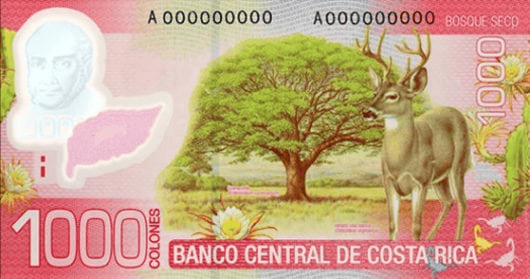
The 1,000 colones banknote features a red main color, a dry forest with a Guanacaste tree, white-tailed deer, a Costa Rican night blooming cactus, and an observer of Braulio Carrillo Colina, the Head of State of Costa Rica from 1835-1837 and 1838-1842, and the 1840-1842 Costa Rican coat of arms.
2,000 colones
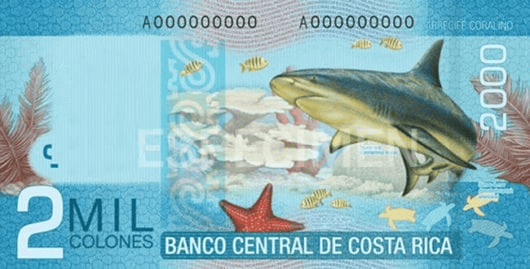
The 2,000 colones banknote features a blue main color, with a reverse featuring a coral reef, bull shark, red cushion sea star, and slimy sea plume. The observer also features lawyer and politician Mauro Fernández Acuña and the Colegio Superior de Señoritas.
5,000 colones
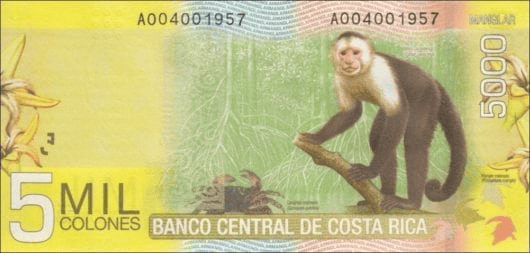
The 5,000 colones banknote features a yellow color, a mangrove swamp, a white-headed capuchin monkey, a mangrove crab, and a red mangrove. The reverse features Alfredo González Flores, Costa Rica’s former President, and the Banco International de Costa Rica building in San José.
10,000 colones
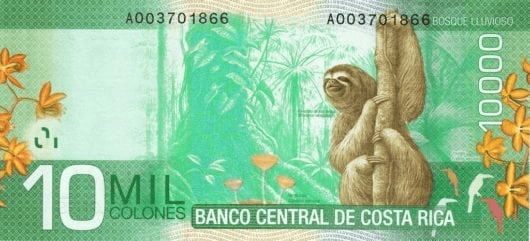
The 10,000 colones banknote features a green main color, a rainforest, brown-throated sloth, cup fungi, and eriopsis orchid on the reverse. The observer features José Figueres Ferrer, Costa Rica’s three-time President, and the Abolition of the Army.
20,000 colones
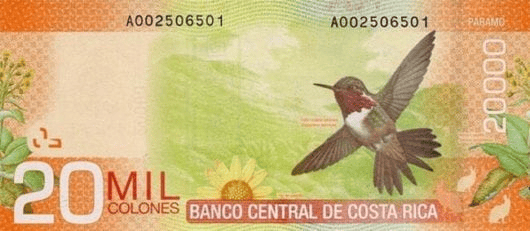
The 20,000 colones banknote features an orange color, with a reverse featuring Paramo, a volcano hummingbird, a sunflower, and coffee plants. The observer features Carmen Lyra, the first prominent Costa Rican writer, an outline of Costa Rica, and a rabbit stroking a wolf from her “Cuentos De Mi Tía Panchita” story.
50,000 colones
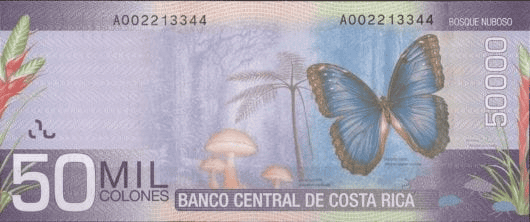
The 50,000 colones banknote features a violet main color, with a cloud forest, parasol mushroom, bromelia flower, and morpho butterfly on the reverse. It features Ricardo Jiménez Oreamuno, Costa Rica’s three-time president and Supreme Court judge.
Currency Usage in Costa Rica
If you are traveling to Costa Rica, you will need to familiarize yourself with the local currency, the Colón. Here are some important things to know about using currency in Costa Rica.
Is USD accepted in Costa Rica?
Yes, US dollars are widely accepted in Costa Rica, especially in tourist areas. However, the exchange rate may not be favorable, and you may receive change in colones. It’s always a good idea to have some colones on hand for smaller purchases and to avoid any issues with exchange rates or fees.
USD is accepted in most tourist areas in Costa Rica, such as popular beach towns and national parks. However, in more remote or rural areas, it may be more difficult to use USD, and you may need to use colones. It’s always a good idea to have some colones on hand for smaller purchases and to avoid any issues with exchange rates or fees.
While USD is widely accepted in Costa Rica, it’s always a good idea to have some colones on hand for smaller purchases and to avoid any issues with exchange rates or fees. You can exchange USD for colones at banks, exchange offices, and some hotels in Costa Rica.
Exchanging Currency in Costa Rica
When traveling to Costa Rica, it is important to have local currency on hand for purchases and tipping. The official currency of Costa Rica is the Colón (CRC), and while US dollars are widely accepted, it is recommended to exchange money for the best exchange rates.
Where can I exchange Costa Rica currency?
When it comes to exchanging your money in Costa Rica, banks and authorized currency exchange centers are your best bet. They often offer better exchange rates than airports or hotels. Some well-known banks in Costa Rica include Banco Nacional, Banco de Costa Rica, and Scotiabank.
Consider also exchanging a small amount of money before your trip. This way, you’ll have some local currency for immediate expenses when you arrive. You can do this at your local bank or a currency exchange service.
Once you’re in Costa Rica, head to the local banks mentioned above for currency exchange. They usually provide competitive rates, and it’s a secure option. Just make sure to check the bank’s hours, as some may close earlier or have limited services on weekends.
If your travels take you to more remote areas with limited banking services, it’s a good idea to have enough local cash. Some smaller towns may have fewer ATMs or limited exchange options.
Using ATMs in Costa Rica is a convenient way to get local currency. Most major cities and tourist areas have ATMs. But don’t forget to check with your bank about international withdrawal fees and inform them about your travel plans to avoid any issues with your card.
Always prioritize safety when carrying cash, and think about using a combination of cash and cards for your financial needs while traveling. Keep in mind that exchange rates can vary between providers, so it’s wise to compare rates and fees before making any currency exchange decisions.
What to know before exchanging currency in Costa Rica
Before exchanging currency in Costa Rica, it is important to know the current exchange rate and any associated fees. It is also recommended to bring bills in good condition, as banks may not accept damaged or torn bills.
When exchanging currency, it is important to count the money received and ensure that the correct amount was exchanged. It is also recommended to keep receipts for the transaction in case of any issues or discrepancies.
Overall, exchanging currency in Costa Rica is a straightforward process. By exchanging money at a bank or authorized exchange center and being aware of the current exchange rates and associated fees, you can ensure that you have the local currency necessary for your travels.
Choosing Between USD and Colón in Costa Rica
When traveling to Costa Rica, you may be wondering whether you should use US dollars or Costa Rican Colóns for your transactions. Both currencies are widely accepted in the country, but there are some factors to consider when choosing which one to use.
Exchange Rate
The exchange rate between the USD and the Colón can fluctuate, so it’s important to check the rate before making any transactions. While the USD is generally more stable, the Colón can sometimes offer better value for money. You can check the current exchange rate using online currency converters like Google, Wise, or XE.
Convenience
US dollars are more widely accepted in Costa Rica, especially in tourist areas. However, some vendors may only accept colóns, so it’s a good idea to carry some local currency with you. You can exchange USD for colóns at banks, exchange bureaus, or ATMs.
Fees
When exchanging currency, be aware of any fees or commissions that may be charged. Some exchange bureaus and ATMs may have higher fees than others, so it’s important to shop around for the best deal. Additionally, some credit cards may charge foreign transaction fees, so it’s a good idea to check with your bank before using your card in Costa Rica.
Tips
Carry a mix of USD and colóns for flexibility, use USD for larger transactions like hotel bills or tours, and colóns for smaller ones like food or souvenirs. Check exchange rates and fees before making transactions, and avoid airports for higher fees.
By considering these factors, you can make an informed decision about which currency to use during your trip to Costa Rica.
Cost of Living in Costa Rica
If you’re planning to visit or move to Costa Rica, it’s important to have an idea of the cost of living in the country. Costa Rica is generally considered to be an affordable destination, with a lower cost of living compared to the United States and other developed countries.
The cost of living in Costa Rica is generally lower than in the United States, but specific costs can vary depending on the region and lifestyle. In some aspects, such as housing and certain services, Costa Rica may be more affordable. However, imported goods and some luxury items can be more expensive.
According to Expatistan, the estimated monthly cost of living for a single person in Costa Rica is around ₡720,734 or $1,360 US dollars as of November 2023. However, this can vary depending on your lifestyle and location. The Cost of living in Costa Rica is more expensive than in 75% of countries in Latin America (5 out of 16) but the cost of living in Costa Rica is cheaper than in 58% of countries in the World (40 out of 69).
In terms of daily expenses, $20 US can go a long way in Costa Rica. This can cover the cost of a meal at a local restaurant, a few groceries, or a bus ride. However, keep in mind that prices can vary depending on the location and type of establishment.
Transportation costs can also add up, especially if you’re relying on taxis or private transportation. A one-way ticket on local transport costs around ₡350, while a taxi ride within the city center can cost around ₡3,000 to ₡5,000.
Food prices can vary depending on where you shop and what you buy. A meal at an inexpensive restaurant costs around ₡5,000, while a meal at a mid-range restaurant can cost around ₡10,000 to ₡15,000. If you prefer to cook at home, groceries can cost around ₡50,000 to ₡70,000 per week for a couple.
When it comes to healthcare, Costa Rica has a high-quality healthcare system. A visit to a private doctor typically costs around ₡50,000. However, it’s important to note that healthcare costs can vary depending on the type of treatment needed.
Overall, while the cost of living in Costa Rica can vary depending on your lifestyle and location, it’s generally affordable compared to many other countries. By budgeting carefully and making smart choices, you can enjoy a comfortable life in this beautiful country.
Don’t Get Scammed Tips
When traveling to Costa Rica, it is important to be aware of currency scams that can occur. Here are some tips to help you avoid being scammed:
1) Use reputable exchange services
When exchanging currency, always use reputable exchange services such as banks or authorized exchange offices. Avoid exchanging money with individuals on the street or in unlicensed establishments, as this can lead to counterfeit bills or being short-changed.
2) Check the exchange rate
Before exchanging money, check the current exchange rate to ensure that you are getting a fair deal. You can do this by checking online or at a reputable exchange office.
3) Be aware of common scams
There are several common scams that tourists may encounter when exchanging money in Costa Rica. One of the most common is the “quick change” scam, where a vendor will try to confuse you by giving you incorrect change or short-changing you. Another scam involves counterfeit bills, where a vendor will try to pass off fake bills as real currency.
4) Inspect your bills
Always inspect your bills carefully before accepting them. Look for signs of wear and tear, as well as any signs of counterfeiting such as blurry printing or missing watermarks. If you are unsure about a bill, ask for a different one.
5) Keep your money safe
When carrying cash, keep it in a secure location such as a money belt or hidden pocket. Avoid flashing large amounts of cash in public, as this can make you a target for thieves and scammers.
By following these tips, you can help protect yourself from currency scams when traveling in Costa Rica. Remember to always be aware of your surroundings and trust your instincts if something seems off.

